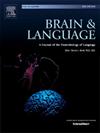核心语言功能背后的神经连接。
IF 2.3
2区 心理学
Q1 AUDIOLOGY & SPEECH-LANGUAGE PATHOLOGY
引用次数: 0
摘要
虽然已经确定了许多语言功能背后的白质束,但即使是总的来说,它们也不能提供一个足够详细和广泛的图景,使我们能够充分理解语言产生和理解背后的计算过程。我们采用弥散张量束图(diffusion tensor tractography, DTT)和张量分布模型来更广泛地探索支持核心语言功能的白质束。我们的研究主要以失语症文献中的假设为指导。方法:采用高角分辨率扩散成像(HARDI)和双感兴趣区示踪成像方法。我们的扩散张量分布模型使用混合的Wishart分布来估计逐体素基础上的水分子位移概率函数,并使用多室方法对交叉/分支纤维进行建模。结果:我们重复了先前发表的关于语言功能底层的研究结果。我们的研究还产生了一些新的发现:1)在布罗卡区和整个额上回之间存在广泛的连通性;2)布洛卡区眶部、三角部、包部和下中央前回四个亚区之间存在广泛的连通性;3)颞中上回与横回的连通性;4)颞中上回、横回、颞平面、颞下回和颞中回之间的连通性;5)颞上回与布洛卡区各组成部分之间的连通性。讨论:这些结果复制了先前DTT研究的结果,也大大扩展了它们,从而提供了语言功能结构基础的更全面的图景,并为语言功能的神经网络架构的新模型奠定了基础。这个新模型与失语症文献的发现和语言功能的并行分布式处理概念完全一致。本文章由计算机程序翻译,如有差异,请以英文原文为准。
Neural connectivity underlying core language functions
Introduction
Although many white matter tracts underlying language functions have been identified, even in aggregate they do not provide a sufficiently detailed and expansive picture to enable us to fully understand the computational processes that might underly language production and comprehension. We employed diffusion tensor tractography (DTT) with a tensor distribution model to more extensively explore the white matter tracts supporting core language functions. Our study was guided by hypotheses stemming largely from the aphasia literature.
Methods
We employed high angular resolution diffusion imaging (HARDI) with a dual region of interest tractography approach. Our diffusion tensor distribution model uses a mixture of Wishart distributions to estimate the water molecule displacement probability functions on a voxel-by-voxel basis and to model crossing/branching fibers using a multicompartmental approach.
Results
We replicated the results of previously published studies of tracts underlying language function. Our study also yielded a number of novel findings: 1) extensive connectivity between Broca’s region and the entirety of the middle and superior frontal gyri; 2) extensive interconnectivity between the four subcomponents of Broca’s region, pars orbitalis, pars triangularis, pars opercularis, and the inferior precentral gyrus; 3) connectivity between the mid-superior temporal gyrus and the transverse gyrus; 4) connectivity between the mid-superior temporal gyrus, the transverse gyrus, and the planum temporale and the inferior and middle temporal gyri; and 5) connectivity between mid- and anterior superior temporal gyrus and all components of Broca’s region.
Discussion
These results, which replicate the results of prior DTT studies, also considerably extend them and thereby provide a fuller picture of the structural basis of language function and the basis for a novel model of the neural network architecture of language function. This new model is entirely consistent with discoveries from the aphasia literature and with parallel distributed processing conceptualizations of language function.
求助全文
通过发布文献求助,成功后即可免费获取论文全文。
去求助
来源期刊

Brain and Language
医学-神经科学
CiteScore
4.50
自引率
8.00%
发文量
82
审稿时长
20.5 weeks
期刊介绍:
An interdisciplinary journal, Brain and Language publishes articles that elucidate the complex relationships among language, brain, and behavior. The journal covers the large variety of modern techniques in cognitive neuroscience, including functional and structural brain imaging, electrophysiology, cellular and molecular neurobiology, genetics, lesion-based approaches, and computational modeling. All articles must relate to human language and be relevant to the understanding of its neurobiological and neurocognitive bases. Published articles in the journal are expected to have significant theoretical novelty and/or practical implications, and use perspectives and methods from psychology, linguistics, and neuroscience along with brain data and brain measures.
 求助内容:
求助内容: 应助结果提醒方式:
应助结果提醒方式:


